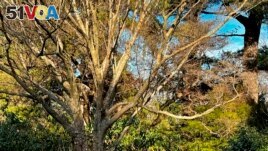As winter comes to an end, gardeners in northern parts of the world look for signs of life.
They look for plants that are growing from roots that were planted in autumn. Many gardeners are looking for the return of leaves to many of their trees.
By planning, people can grow plants that keep their gardens interesting to look at even during cold periods.

This shows a garden with trees that keep their leaves in the winter trees that lose them in Oyster Bay, NY on February 21, 2022. (Jessica Damiano via AP)
Here are some suggestions for planning an interesting winter garden:
First, create a wall in the back of the garden with plants that keep leaves throughout the year. That way, when some plants lose their leaves, the garden will still have structure that provides privacy and interest for the eye.
Next, consider how the garden looks from the street. It matters how others see the garden. But the person who sees it the most is the gardener and those who live in the house.
Gardeners should consider where they spend most of their time. Do they spend a lot of time looking at one part of the garden? They should study how the garden looks from indoors.
When choosing plants, consider how all parts of the plant, from the fruit to the bark, will improve the garden’s appearance.
Some plants that are interesting to see in the winter do not look very good during the summer. The red twig dogwood, also known as the Cornus alba, will leave a bright red leafless bush in the winter.
Another bush that is beautiful in the winter is the American beautyberry, also called Callicarpa Americana. It is from the Southeast United States and leaves small bright purple fruits, or berries, that hang on all winter – or until the birds eat them.
Winterberry holly is another bush from North America. It has bright red berries in the winter that are just as pleasing for the eyes as they are for the birds. Plant one male for every six to eight female plants to make sure they produce fruit.
Trees with beautiful bark can draw people in as well. The bark of the paperback maple peels back to a rich-red bark underneath. Another tree, the paper birch provides four seasons of interest. It has beautiful leaves in the fall and beautiful bark that begins to peel when the tree is about 3 years old.
Animals in the garden
Plants are not the only interesting thing in the winter garden. Think about wildlife. A bird feeder that can be seen from inside the home can have a calming effect on everyone. Place it outside the children’s bedroom windows and the children will enjoy its calming effects without even knowing it.
Grasses like little bluestem, fountain grass, and sea oats, can be left standing until spring. They provide a shelter for wildlife and insects over the winter. They also are a beautiful sight for the borders of gardens and their seeds provide food for hungry birds.
However, there are some plants that gardeners should clear away in fall. The hosta plant is a favorite home in the winter for a damaging garden creature, the slug. The plants should be cut back when the colors become lighter. Another plant, the iris, should be cut back because it can shelter harmful insect eggs.
Plants that showed signs of disease during the past growing season should be removed before winter. Additionally, some flowering plants that come back each year should be cut back to prevent disease. They include the bee balm, peony, and phlox.
I’m Gregory Stachel.
Jessica Damiano reported this story for The Associated Press. Gregory Stachel adapted it for VOA Learning English.
____________________________________________________________________
Words in This Story
garden – n. an area of ground where plants (such as flowers or vegetables) are grown
bark – n. the outer covering of a tree
bush – n. a plant that has stems of wood and is smaller than a tree
peel – v. to lose an outer layer of skin or bark
We want to hear from you. Write to us in the Comments section, and visit 51VOA.COM.
